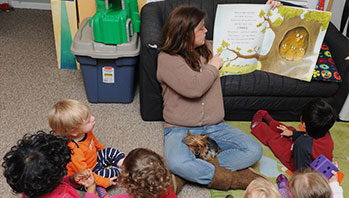- grain
- grow
- plant
MA Standards:
English Language Arts/Literature/RL.PK.MA.1: With prompting and support, ask and answer questions about a story or a poem read aloud.
English Language Arts/Literature/RL.PK.MA.4: With prompting and support, ask and answer questions about unfamiliar words in a story or poem read aloud.
English Language Arts/Literature/RL.PK.MA.10: Listen actively as an individual and as a member of a group to a variety of age-appropriate literature read aloud.
Head Start Outcomes:
Literacy Knowledge/Book Appreciation and Knowledge: Asks and answers questions and makes comments about print materials.
PreK Learning Guidelines:
English Language Arts/Reading and Literature 6: Listen to a wide variety of age appropriate literature read aloud.
English Language Arts/Reading and Literature 10: Engage actively in read-aloud activities by asking questions, offering ideas, predicting or retelling important parts of a story or informational book.
Read Together: The Little Red Hen #1

© Commonwealth of Massachusetts, Department of Early Education and Care (Jennifer Waddell photographer). All rights reserved.
STEM Key Concepts: Plants need water and sunlight to grow
ELA Focus Skills: Listening and Speaking, Story Comprehension, Vocabulary
Educator Prep: You may want to replay the Between the Lions video “Help” to help children recall the little red hen story.
Hold up the book The Little Red Hen by Paul Galdone for children to see. Ask children if they recognize the animal on the cover. Help them recall the little red hen story they watched in the video Between the Lions “Help.”
Before You Read
Have children read the title with you as you track the words with your finger. Tell children you are going to read a different version of the little red hen story. Ask, What other story did we read different versions of last week? (The Three Little Pigs) Remind them that different authors write the same story but they write some details that are different.
Set a reading focus for children by asking them to listen for whether or not the little red hen does the same things in this story as the character in the video.
As You Read
Read slowly and with expression and use a different voice for each character.
- Have children chime in when the dog, cat, and mouse say “Not I!” and the hen says “Then I will.”
- Ask, Does the hen ask for help with the same things in this story as in the video?
- Pause at the pages when the little red hen plants the grains. Ask, Why did the little red hen plant the seeds herself? Was this the same or different than the little red hen in the video?
After You Read
Talk about the story with children.
- Why did the little red hen do all the work herself? How was this the same or different from the video?
- Why didn’t the animals help the little red hen? Was this the same reason the animals in the video did not help?
- Remind children that this story is a folktale and it has many different versions. How is this version of the story like the one in the video? How is it different?
- Which version of the little red hen story do you like better? Why?
Take It Further: Talk with children about the multiple meanings of the word ground. Reread the sentence “I took the wheat to the mill to be ground into flour.” Ask, What does the word ground mean here? Does it mean the dirt under our feet? Help children explore the different meanings of the word (soil, dirt; to break apart into small pieces). Discuss other items that can be ground (e.g., coffee beans, pills, crackers).
